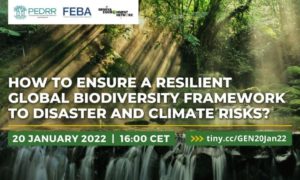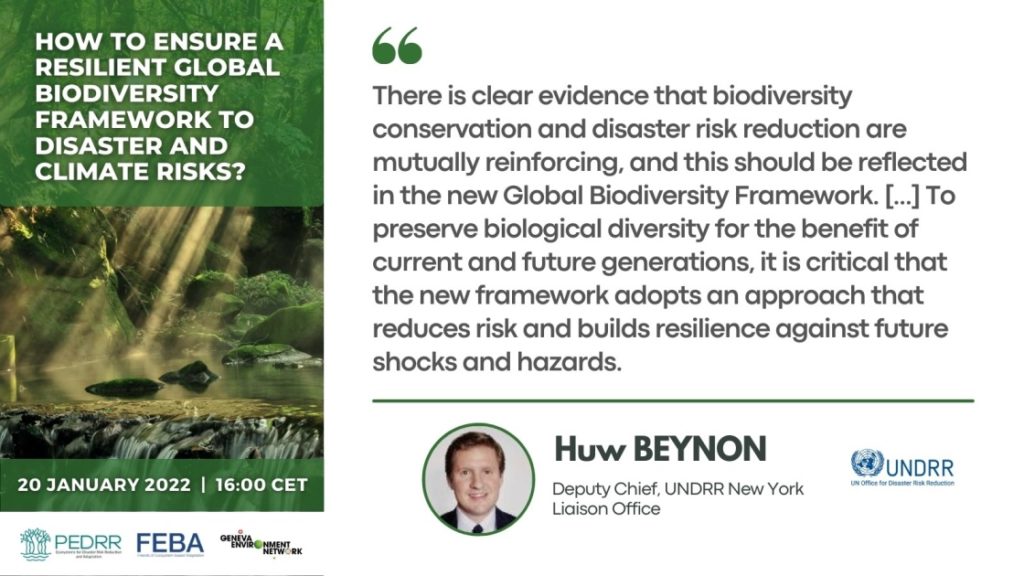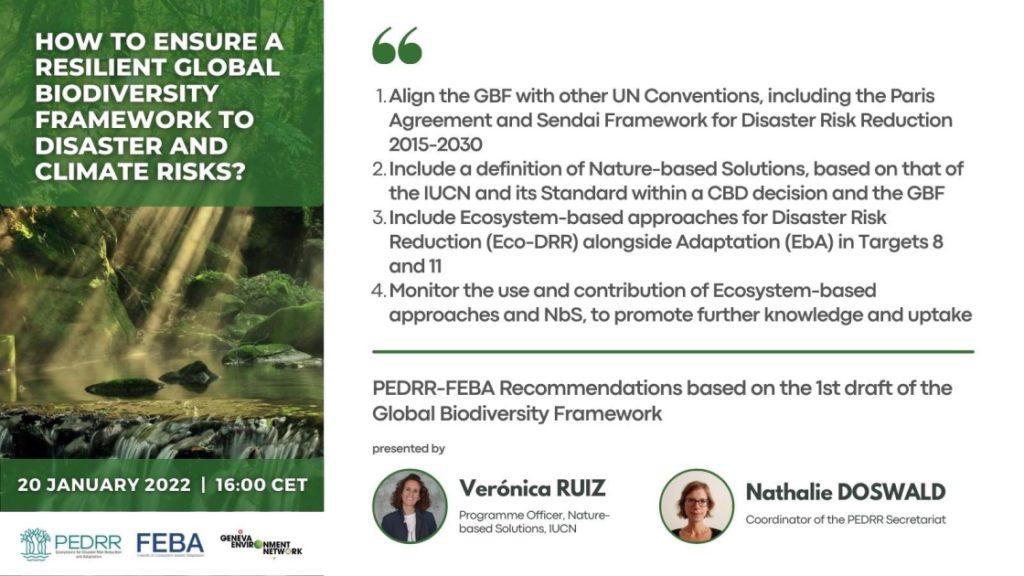Event Virtual
How to Ensure a Resilient Global Biodiversity Framework to Disaster and Climate Risks?

20 Jan 2022
16:00–17:15
Venue: Online | Webex
Organization: Partnership for Environment and Disaster Risk Reduction, Friends of EbA, Geneva Environment Network
This event, co-convened by the Partnership for Environment and Disaster Risk Reduction (PEDRR), Friends of Ecosystem-based Adaptation (FEBA), and the Geneva Environment Network aimed at drawing attention to the importance of integrating resilience in the Global Biodiversity Framework for greater alignment with the Sendai Framework for Disaster Risk Reduction 2015-2030, the Paris Agreement and the new Glasgow Pact, prior to the final face-to-face negotiations of the Post-2020 Global Biodiversity Framework to take place early in 2022.

About this Session
In the first quarter of 2022, Parties to the Convention on Biological Diversity (CBD) will meet to negotiate the text of the new Global Biodiversity Framework. This meeting is important as it leads up to the 2nd half of the 15th meeting of the Conference of the Parties to the Convention (COP15), scheduled to take place in Kunming, in 2022.
The first half of COP15 in October 2021, resulted in the Kunming Declaration and pledges for committing to Biodiversity Funds for implementation of the Global Biodiversity Framework. Furthermore, Parties committed to development, adoption and implementation of an effective post-2020 Global Biodiversity Framework.
However, to achieve the overarching goals of protecting and enhancing biodiversity, the new Global Biodiversity Framework requires provisions to ensure the resilience of biodiversity and ecosystems in the face of climate change and increasing disaster risk. These provisions would need to include ecosystem-based approaches for disaster risk reduction and climate change adaptation
There is a need for greater alignment in the new Global Biodiversity Framework with other important global frameworks, namely the Sendai Framework for Disaster Risk Reduction 2015-2030, the Paris Agreement and the new Glasgow Pact, which have recognized the importance of ecosystem-based approaches or nature-based solutions for protecting biodiversity and reducing disasters and climate change impacts. In particular, the Sendai Framework has called on the environment and conservation community to promote biodiversity and ecosystem management as critical measures for reducing disaster and climate risks.
The event discussed:
- Increasing disaster and climate risks globally and how they impact on biodiversity and ecosystems, and the importance of integrating resilience in the new Global Biodiversity Framework;
- Country level experiences on how biodiversity and ecosystem-based approaches have been successfully applied to reduce disaster risks and support climate change adaptation;
- Proposed recommendations for incorporating disaster and climate resilience in the new Global Biodiversity Framework.
Speakers

Marisol ESTRELLA
Programme Coordinator for Disaster Risk Reduction, Disasters and Conflicts Branch, UNEP

Takashi MIZUSHINA
First Secretary, Permanent Mission of Japan to the International Organizations in Geneva

Huw BEYNON
Deputy Chief, UNDRR New York Liaison Office

Verónica RUIZ
Programme Officer, Nature-based Solutions, IUCN
Summary
Opening Remarks
Marisol Estrella | Programme Coordinator for Disaster Risk Reduction, Disasters and Conflicts Branch, UNEP | PEDRR
- The Partnership for Environment and Disaster Risk Reduction or PEDRR, established in 2008, is a global alliance of 28 organizations from the conservation, disaster risk reduction (DRR), humanitarian and climate communities – bringing together our collective expertise and working with Member States and local communities to apply ecosystem-based approaches – or nature-based solutions (NbS) – for increasing disaster and climate resilience. It is also one of the most long-standing partnerships promoting ecosystem-based DRR and adaptation.
- This event comes at an important crossroads, as our global community faces a triple global emergency:
- Climate change and its impacts on increased disasters and extreme weather events.
- Biodiversity loss.
- The COVID-19 pandemic.
- These three global emergencies are linked through the ways we choose to manage or mismanage nature. The good news is that the reverse is true: healthy, well-managed ecosystems and their underlying biodiversity, provide critical services which make nature and people more resilient.
- We rely on ecosystems for food, water, for fueling our economies but also for providing natural buffers and protection against disasters and climate impacts. For instance, healthy reef systems can reduce storm surge wave impacts on our coastlines. In Switzerland, forests are carefully managed to mitigate risks of avalanches, landslides and rockfalls, protecting villages and important economic assets. In other words, working with nature – protecting biodiversity and managing ecosystems sustainably – are at the core of people’s well-being and resilience.
- Over the last 15 years, the Member States and our global communities have recognized that nature is key to enhancing our resilience to climate change and disasters. Our global agendas are much more closely aligned than ever before.
- Countries adopted the Sendai Framework for Disaster Risk Reduction 2015-2030 which recognized the role of biodiversity and ecosystem-based approaches for reducing disaster and climate risks.
- Parties to the CBD have echoed a similar message through its adoption of multiple decisions particularly in COP 12 in 2014 which advocated for joint efforts in biodiversity, climate change and disaster risk reduction.
- Similar actions have been taken by Parties of the Ramsar Convention, UNCCD and other biodiversity-related conventions. This required working collectively in partnership – bringing together the conservation, DRR and climate communities – and our shared goals.
- This year, Parties to the CBD will agree on the new Global Biodiversity Framework (GBF). It will be important to build on the historical cooperation and achievements already made by the Member States in promoting ecosystem-based or nature-based solutions for DRR, climate change mitigation and adaptation. It is crucial to build-in resilience into the new GBF if we are to look towards a future of living in harmony with nature.
- Today’s event aims to bring attention once again to these important efforts and shared goals.
Sonia PEÑA MORENO | Director of the International Policy Centre | IUCN
- Friends of Ecosystem-based Adaptation (FEBA) is a global collaborative network of 90 plus agencies and organizations involved in ecosystem-based adaptation (EbA), working jointly to share experiences and knowledge to improve the implementation of EbA on the ground and to have a stronger and more strategic learning and policy influence on EbA. FEBA partners, of which IUCN is part, work together to promote EbA integration into the implementation of the Paris Agreement and raise awareness and understanding of EbA in adaptation planning processes and multilateral policy frameworks.
- The CBD recognized FEBA, through decision 14/5 in Egypt, as a key partner to support parties in their efforts to promote ecosystem-based approaches to climate change adaptation.
- Parties to the CBD are negotiating the GBF for this decade and beyond. This framework aims to halt the loss of biodiversity and ensure the vision of a world of living in harmony with nature by 2050. Unfortunately, due to the pandemic and the many delays in the process, negotiations have become slow-paced, and meetings have been turned into virtual gatherings and discussions to try to shape and work on the structure of this global framework, its goals and targets. But for many, what has happened so far is not enough.
- The current text of the GBF is very complex, but the scheduled CBD meetings to take place in Geneva in March will give a very good opportunity to provide input into the process and shape that framework in a way that turns it into being fit for purpose.
- IUCN is of the view that the GBF must be a truly global framework and a unified action plan that actually integrates not only the objectives of the CBD but the other two Rio Conventions, other biodiversity-related conventions and other processes such as the Sendai Framework for Disaster Risk Reduction 2015-2030, ensuring the full alignment with the SDGs. It wouldn’t make sense otherwise, and this synergistic approach is not only desired, but it’s a precondition for a successful global, biodiversity framework.
The interlinkages across all of these interconnected processes and issues can be further enhanced and improved through the application at a scale of nature-based solutions.
- NBS can address those challenges, enhance human well being, support the aims of a wide variety of policies, including those that relate to human health, climate change, disaster risk reduction, combating decertification, etc., while at the same time enhancing biodiversity and ecosystem functions. So we thus want to see the text and the reference of the global biodiversity framework, including, NbS in one of the targets that are being discussed.
- So, what do we want to see ultimately adopted in Kunming and implemented the decade beyond? An ambitious yet simple science-based global plan to drive action by all parts of society to conserve our diversity and indeed our livelihoods and people’s resilience; a framework that reflects the urgency of transforming our societies the way we produce we consume; and to maintain and secure the planet’s life support system, thus getting us to ensuring a so-called nature positive world.
Panel Discussion
Takashi MIZUSHINA | First Secretary | Permanent Mission of Japan to the International Organizations in Geneva
- The experience of Great East Japan after the earthquake of 2011 brought major changes to society in the country, particularly in the context of DRR: it made us aware of the need for comprehensive DRR strategies in preparation for the disasters in our worst-case scenarios. These circumstances led to an increased awareness of the importance of Ecosystem-based Approaches.
- In Japan, Eco-DRR is not a new concept but a traditional approach. The country has a long tradition of conserving and making use of local ecosystems to reduce disaster risks, for example, coastal forests for preventing high tides.
- Wetlands contribute to DRR. As an example, the two Ramsar sites, Watarase-yusuichi, that prevented Tokyo from flood damages during the typhoon in 2019, and Kushiro-shitsugen, a natural reservoir that reduces river flows by approx. 30%.
- I would like to highlight two efforts by the Mystery of the Environment of Japan, to promote the implementation of Eco-DRR on the ground. The first one is the development of the Handbook on Ecosystem-based Disaster Risk Reduction in Japan, which introduces the basic concepts of Eco-DRR and summarizes its advantages and challenges, introducing specific examples and shared mainly with local governments. The second is the creation of “Potential Maps” showing the function of ecosystems and assessing areas suited for Eco-DRR.
- Japan has a traditional approach to Eco-DRR so we would like to continue our efforts based on these perspectives.
Case study: Ecosystem restoration and disaster risk reduction in Colombia | Video
Huw BEYNON | Deputy Chief, UNDRR New York Liaison Office
- The COVID 19 pandemic, the climate emergency and the biodiversity crisis have demonstrated the complex and increasingly systemic nature of risk, exposing entrenched weaknesses within our economic, social and environmental systems. As the environment interacts with everything that we do, systemic risk can only be reduced by working with rather than against nature. Therefore, UNDRR advocates strongly for a comprehensive approach to risk management.
- Member states have already agreed on the importance of NbS for DRR, as well as the value of risk reduction practices for ecosystem protection. Several intergovernmental agreements and declarations already give clear policy guidance in this area, most notably, the Sendai Framework, urging all countries to strengthen sustainable use and management of ecosystems to build resilience. Upon this approach, the framework recognizes the need for greater collaboration between global and regional mechanisms for DRR, biodiversity and the environment.
- I would highlight the United Nations General Assembly and its annual segment on DRR, through its resolution that affirms strong commitment, coordination, and coherence between the implementation of the Sendai Framework and the CBD. On this resolution, the Assembly calls for all countries to translate this integration between global policy frameworks, international laws, policies and regulations. The value of NbS also features prominently at the regional platform of DRR. These platforms are convened every two to three years, and in November 2021 they were hosted by the governments of Jamaica, Kenya, Morocco, and Portugal, as well as the UNDRR. The platforms give good guidance to the regional level on how to implement the Sendai Framework.
- Last year through the political declarations and the action plan that came out to the regional platform, countries agreed that risk-informed development requires greater coherence across policies and activities for DRR, climate change adaptation and biodiversity conservation. There is also a clear need for scaling up investments in NbS for DRR.
- While the Kunming Declaration recognizes that interrelated crises post risks for people and the planet, and recognizes that EbA can boost resilience, this does not go so far as to call for a risk-informed approach on the new GBF. Even though we know there is clear evidence that biodiversity conservation and DRR are mutually reinforcing, this needs to be reflected in the new GBF. Therefore I would like to highlight a few bottlenecks that prevent coherence in policies at the national and local levels that could be addressed in the new GBF.
- The first is around the lack of coherence in data collection and analysis. Most risk assessments conducted by the DRR community do not usually take environmental considerations into account. Conversely, environmental assessment often does not take into consideration risk assessments.
- The second is on risk governance and coordination mechanisms that are not often conducive for coherence. EbA should be incorporated into strengthening risk governance from the local level all the way to the transboundary level. One clear way to do this is to integrate NbS into national and local DRR strategies.
- The third and maybe arguably most importantly is financing. We know that for every 100 dollars allocated for disaster financing, only 50 cents go to risk reduction. One clear way to increase investment in NbS for DRR is through infrastructure. This was recognized in the Global Platform 2019, and the Chair’s Summary called on countries to capitalize on the co-benefits of EbA and to leverage complementarity across blue, green and grey infrastructure. To support this approach, one idea could be to include NbS within principles and standards for recipients’ infrastructure. Both green and grey infrastructure can also be included in pipelines of investor-ready projects that are developed by countries to be financed by International Financial Institutions, development banks and the private sector.
- In closing, let me highlight the midterm review of the Sendai Framework mandated by the United Nations General Assembly. It will culminate in a high-level meeting at the United Nations General Assembly in May 2023, and the political declaration should provide policy guidance on this topic. Moreover, the United Nations Secretary-General has already called for the COP on the CBD to consider including DRR in its work, thus focusing on NbS promoting the application of DRR in the implementation of the new GBF.

Sandeep SENGUPTA | Global Coordinator of Climate Change Portfolio, IUCN
- Historically there has been a strong recognition of the importance of ecosystems within the UNFCCC and the Paris agreement. Back to the adoption of the UNFCCC in 1992, it is quite outstanding that even in the objective of the text itself, there is a clear call for the stabilization of greenhouse gas concentrations in the atmosphere within a timeframe that is sufficient to allow ecosystems to adapt naturally. In the Paris Agreement of 2015, this recognition is continued to be highlighted. Moreover, there are strong references to the contribution that ecosystems can play in core parts of the Agreement itself.
- In the last couple of years, there have been growing convergences of biodiversity and the climate agendas particularly depicted in the framing of NbS. Perhaps the most prominent example of this is the 2019 Climate Action Summit in New York that was convened by the United Nations Secretary-General, which included for the first time a dedicated track on NbS that was co-chaired by China and New Zealand, and which resulted in our NbS for Climate Manifesto. This recognition of NbS has been subsequently reiterated as well in the Leader’s Pledge for Mature in October 2020 in the United Nations General Assembly.
- Last September, in the IUCN World Conservation Congress in Marseille, a clear message came out from our members, recognizing very clearly the interlinked nature of the biodiversity and climate crisis that the world is facing today, along with the COVID19.
- Increasingly countries have begun to incorporate solutions within their national climate strategies and plans, and explicitly within their NDCs under the Paris Agreement.
- Last year there was also the release of the IPBES – IPCC joint workshop report on biodiversity and climate change which also incorporated and referenced NbS.
Nature-based Solutions are defined as “actions to protect, sustainably manage, and restore natural or modified ecosystems, that address societal challenges effectively and adaptively, simultaneously providing human well-being and biodiversity benefits.” This definition was adopted at the IUCN World Conservation Congress 2016 in Hawaii, and it is the most widely used definition to this day.
- NbS was one of the five thematic priorities of the UK COP 26 presidency going into Glasgow 2021, and one of the remarkable factors about COP26 was the unprecedented attention that was given to nature and NbS. In this meeting, IUCN and UNEP launched the Report on Nature-based Solutions for climate change mitigation that reviewed, not only the previous studies but a range of other peer-reviewed assessments that have tried to estimate the potential of NbS in terms of carbon sequestration and storage benefits. The highlight from this study was that NbS are critical for achieving the Net Zero goal of the Paris Agreement.
- Because of the increasing recognition of the contribution of NbS, from mitigation, adaptation and DRR perspective to climate change, we find countries at the national level incorporating NbS within their Nationally Determined Contributions under the Paris Agreement. In 2019, IUCN and Oxford University prepared this report, which found that around 66% of Paris Agreement signatories had incorporated NbS within their NDCs in one form or another. But what we found is that many of these were still general references and that they needed to be made much more concrete and quantitative.

PEDRR-FEBA Recommendations
Verónica RUIZ | Programme Officer, Nature-based Solutions, IUCN
Nathalie DOSWALD | Coordinator of the PEDRR Secretariat
The recommendations listed below are availabe in the PEDRR/FEBA Recommendations Brief based on the 1st draft of the Global Biodiversity Framework (GBF).
1. Align the GBF with other United Nations conventions and international agreements
- Climate change, together with human exploitation and degradation of ecosystems, is causing a widespread loss of biodiversity and decline in ecosystem functionalities leading to ecosystem collapse and reduced provision of ecosystem services. Promoting the coherent implementation of the Rio Conventions is critical in order to better address the interrelated challenges of climate change, land degradation and biodiversity loss. This alignment can lead to the development of robust indicators, the reinforcement of interlinkages, achievement of targets and most important: it can contribute to breaking the silos and looking towards a holistic and integrative way of working.
- Simultaneous investment in ecosystem restoration, the rehabilitation of degraded agricultural and pasture lands, and ways to sustainably enhance agricultural productivity can contribute to combating climate change and biodiversity loss and enhance food security at the same time.
2. Include a definition of NbS, based on IUCN and its standard in a CBD decision and GBF
- The increasing demand for NbS has led to cases of misuse of the concept, and even good intentions can result in harm to nature and people. That is when the IUCN Global Standard on NbS can help. Nevertheless, neither the IUCN definition nor the Global NbS Standard have been fully recognised in global policy frameworks across the board with a few notable exceptions.
- This definition was adopted and recognised by IUCN at the 2016 World Conservation Congress in Hawaii, the Global Standard as well as a resolution at the postponed Congress in Marseille back in September 2021. The definition primarily relies on the foundation that interventions cannot have a negative impact on biodiversity. However, misapplication and misuse of the concept is a real concern, that is why the IUCN Standard relies on biodiversity and human rights safeguards to dismiss any intervention that harms nature and human well-being.
3. Include Eco-DRR alongside EbA in targets 8 and 11
- Target 8 is about threats to Biodiversity. We need to include Eco-DRR alongside EbA because disasters impact biodiversity. The Australian bush fires 2019-2020 burned over 97,000km2 of vegetation, affecting the habitat of over 800 species. Research shows that 70 species, lost over 30% of their range. This means that for many species, we may need to revise their threat status. What caused these fires? Alongside climate change, poor land-use management. Eco-DRR can improve land management and reduce fire risk.
- Target 11 is about nature’s contribution to people. We need to include Eco-DRR alongside EbA because ecosystems protect people from disasters. An example is Yala National Park in Sri Lanka which was hit by a tsunami in 2004. The ecotourism resort was protected by sand dunes so that only 5cm of water reached and no casualties. Nearby, the Yala Safari resort had removed the sand dunes for a better ocean view. There, the wave height reached 7 meters and resulted in 27 casualties.
4. Monitor use and contribution of NbS to promote further knowledge and uptake
- Ecosystem-based approaches are currently not reflected in the indicators. We need to monitor their use and contribution to further promote knowledge and uptake. Suggested indicators are stated in this brief.

Video
In addition to the live WebEx and Facebook transmissions, the video will be available on this webpage.
Documents
Links & Resources
- Partnership for Environment and Disaster Risk Reduction | PEDRR
- Friends of Ecosystem-based Adaptation | FEBA
- Nature-based Solutions for climate change mitigation | UNEP & IUCN | 4 November 2021
- Nature’s solutions to landslides: a case study from Colombia | PEDRR | 2 November 2021
- PEDRR/FEBA Recommendations based on the 1st draft of the Global Biodiversity Framework (GBF) | PEDRR | 1 November 2021
- Words into Action: Nature-based solutions for disaster risk reduction | UNDDR | 2021
- Promoting Nature-based Solutions in the Post-2020 Global Biodiversity Framework | PEDRR and FEBA | 13 October 2020
- IUCN Global Standard for Nature-based Solutions | IUCN | 2020
- Nature-based solutions in nationally determined contributions | IUCN & University of Oxford | 2019
- 2019 Global Assessment Report on Disaster Risk Reduction | UNDDR
- MOOC on Nature-based Solutions for Disaster and Climate Resilience | PEDDR
- ICF Evidence Project: Nature-based Solutions ‘Triple Win Toolkit’ | JNCC | 6 September 2016
- Defining Nature-based Solutions | IUCN | 2016
- Faith for Earth Initiative | UNEP
- Words into Action: Nature-based Solutions for Disaster Risk Reduction | UNDRR
- Post-2020 Global Biodiversity Framework | CBD
- Eco-DRR: What are IUCN’s solutions? | IUCN
- Sendai Framework for Disaster Risk Reduction 2015-2030
- Nature-based Solutions for Disaster and Climate Resilience | UN SDG Learn
- Ecosystem-based Disaster Risk Reduction in Japan | Japan Ministry of the Environment | 2016
- An economic analysis of ecosystem-based adaptation and engineering options for climate change adaptation in Lami Town, Republic of the Fiji Islands | SREP | 2013
- Environmental Disaster Risk Reduction | Geneva Environment Network
- Geneva Nature-based Solutions Dialogues | IUCN & Geneva Environment Network | April-December 2021
- Nature-based Solutions Resources compiled by the Geneva Environment Network



